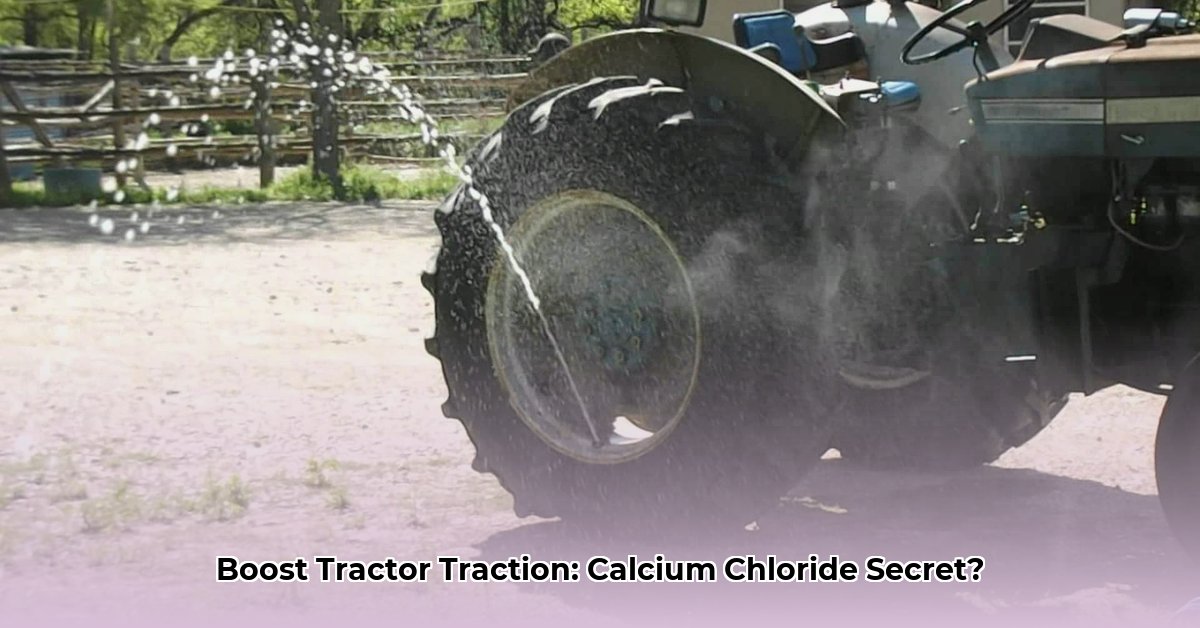
Choosing the right ballast for your tractor tires is crucial for optimal performance and safety. This guide focuses on calcium chloride, comparing its benefits and drawbacks to other options like water, antifreeze, and beet juice. We'll provide step-by-step instructions for safe application and disposal, ensuring you make an informed decision. For more in-depth information, see our comprehensive guide on tractor tire loading.
Why Ballast Tractor Tires?
Poor tire ballast leads to reduced traction, especially on inclines or in wet conditions. This increases the risk of slippage, making work inefficient and dangerous. Adding ballast significantly improves traction by increasing the tire's weight and lowering the tractor's center of gravity. This results in enhanced stability and a reduced risk of rollovers. Isn't safety a top priority?
Ballast Options: A Comparison
Several options exist for ballasting tractor tires, each with its own set of advantages and disadvantages. Let's examine the most common choices:
Water
- Pros: Inexpensive and readily available.
- Cons: Freezes in cold weather, rendering it ineffective during winter months and offering minimal weight increase.
Antifreeze (Propylene Glycol)
- Pros: Effective freeze protection, relatively low toxicity (compared to ethylene glycol).
- Cons: More expensive than water or calcium chloride; improper disposal harms the environment.
Beet Juice
- Pros: Environmentally friendly, good freeze resistance, promotes soil health.
- Cons: Higher cost and limited availability in certain regions.
Calcium Chloride
- Pros: Cost-effective, excellent freeze protection, widely available.
- Cons: Highly corrosive to rims and valves; requires careful handling and disposal to minimize environmental impact.
Calcium Chloride: Detailed Guide
Calcium chloride (CaCl₂) offers a compelling balance between cost and performance, especially in colder climates. However, its corrosive nature demands careful consideration and appropriate safety precautions.
Pros and Cons of Calcium Chloride
Advantages:
- Cost-effectiveness: A significantly cheaper option compared to beet juice or antifreeze.
- Effective weight increase: Provides substantial weight for improved traction and stability.
- Excellent freeze protection: Remains liquid even at very low temperatures.
- Wide availability: Easily sourced from agricultural supply stores.
Disadvantages:
- Corrosion risk: Can corrode rims and valves if not handled properly. Regular inspection is crucial.
- Handling hazards: Irritating to skin and eyes; always wear protective gear.
- Environmental impact: Improper disposal can pollute soil and waterways; adhere to local regulations.
Applying Calcium Chloride: Step-by-Step Instructions
- Inspect tires and rims: Thoroughly examine for any damage before proceeding. Repair any imperfections. (A preventative measure against unforeseen issues.)
- Mix the solution (if necessary): Follow the manufacturer's instructions for the appropriate dilution ratio with water.
- Fill tires slowly: Add the solution gradually, frequently checking tire pressure to avoid overfilling.
- Regular monitoring: Periodically check tire pressure and inspect for leaks or corrosion, particularly around valve stems and rim edges.
Maintenance and Disposal
Regular inspections are critical for preventing significant tire or rim damage. Look for corrosion around valve stems and rim edges. Address any issues promptly. Dispose of used calcium chloride solutions according to local environmental regulations. This is vital for minimizing environmental contamination.
Calcium Chloride vs. Other Options: A Comparison Table
| Ballast Type | Freezing Point (°F) | Environmental Impact | Corrosiveness | Cost | Weight Density (approx.) |
|---|---|---|---|---|---|
| Water | 32 | Low | Low | Very Low | Low |
| Antifreeze (Propylene Glycol) | -35 (50/50 mix) | Moderate | Low | Medium | Moderate |
| Calcium Chloride | -50/-60 | Moderate | High | Low | High |
| Beet Juice | Varies, ~-35 | Low | Low | High | Moderate |
Note: The properties above represent averages and can vary based on product formulations and environmental factors. Always consult the manufacturer's specifications.
Conclusion: Choosing the Right Ballast
Selecting the appropriate ballast depends on several factors: climate, budget, environmental concerns, and accessibility. This guide provides the necessary information to make an informed decision, ensuring your tractor operates efficiently and safely while minimizing potential environmental impact. Prioritize safety and responsible disposal practices to protect your equipment and the environment.